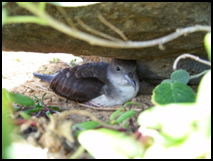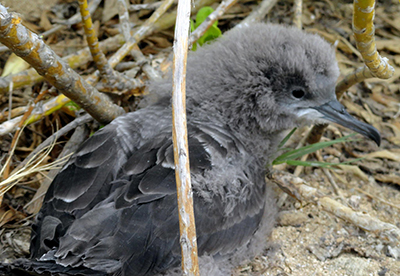 Wedge-tailed Shearwater / Puffinus pacificus chlororhynchus / ‘Ua‘u kani
Wedge-tailed Shearwater / Puffinus pacificus chlororhynchus / ‘Ua‘u kani
Description
Dark brown to brownish-gray above with white underparts except dark wing margins and undertail-coverts. A wedge-shaped tail and a slender, slate-grey hooked bill. Legs and feet are flesh colored. Length: 41-46 cm (16-18 in); wingspan: 97-104 cm (38-41 in); average life span: 10-11 years. Loud groans, moans, and wails resulted in island residents giving them the name "moaning bird." Vocalizations occur primarily at night in breeding colonies.
Population
Approximately 900 burrows as of 2012 census; located in the Nu’upia Ponds complex Habitat ‘Ua‘u kani nest in colonies, occupying natural crevices or burrows dug with its bill and feet.
Feeding Habits
‘Ua‘u kani feed during the day singly or in multi-species flocks. Consume larval forms of goat fish, mackerel scad, flying fish, and squid, driven to the surface by schools of predatory fish (e.g., skipjack tuna).
 Breeding
Breeding
Monogamous. Strictly nocturnal over breeding colony. Their courtship ritual begins shortly after arrival in early March at which time they will establish territories and dig burrows in preparation for egg-laying in June. A pair will sit head to head, often near their burrow entrance, vocalizing two-part wailing duets. Returning to the same nest site or area each year, ‘ua‘u kani nest in shallow burrows, 1-2 meters in length. ‘Ua‘u kani are very synchronous nesters – all lay 1 egg within a 3-week period. A single, large, white egg is laid in a nesting chamber at the end of burrow. Egg-laying begins around the second week of June and continues throughout the month. No relaying will occur if an egg is lost. Incubation period averages 53 days with both parents alternating shifts on the egg, with each shift lasting as long as 12 days. Chicks hatch during late-July through late August. Parents feed regurgitated squid and stomach oil to chicks. Feeding takes place every 24 hours. Fledging occurs in approximately 110 days.
Protection
Nov - Dec is the annual “Shearwater fallout” season on base and around the islands. Juvenile Wedge-tailed Shearwaters (seabirds) are learning to fly. Often disoriented by base lights, they fly inland instead of towards the sea, fall to the ground and get injured or become vulnerable to predators, vehicle strikes, etc.
If found, please call the trained rescue squad:
Environmental Dept
(808) 257- 7000
(808) 216-7135
(808) 520-3641
MCB Hawaii Animal Control Officers
(808) 257-1821
After Hours - MP Desk Sergeant
(808) 257-2123
For more information, click HERE to download the Shearwater Information Flyer.
Click here to read more about the Shearwater.